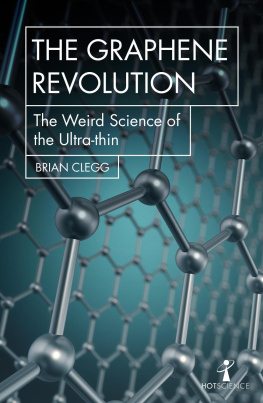Clegg - The graphene revolution: the weird science of the ultrathin
Here you can read online Clegg - The graphene revolution: the weird science of the ultrathin full text of the book (entire story) in english for free. Download pdf and epub, get meaning, cover and reviews about this ebook. City: London, year: 2018, publisher: Icon Books Ltd, genre: Detective and thriller. Description of the work, (preface) as well as reviews are available. Best literature library LitArk.com created for fans of good reading and offers a wide selection of genres:
Romance novel
Science fiction
Adventure
Detective
Science
History
Home and family
Prose
Art
Politics
Computer
Non-fiction
Religion
Business
Children
Humor
Choose a favorite category and find really read worthwhile books. Enjoy immersion in the world of imagination, feel the emotions of the characters or learn something new for yourself, make an fascinating discovery.

- Book:The graphene revolution: the weird science of the ultrathin
- Author:
- Publisher:Icon Books Ltd
- Genre:
- Year:2018
- City:London
- Rating:4 / 5
- Favourites:Add to favourites
- Your mark:
- 80
- 1
- 2
- 3
- 4
- 5
The graphene revolution: the weird science of the ultrathin: summary, description and annotation
We offer to read an annotation, description, summary or preface (depends on what the author of the book "The graphene revolution: the weird science of the ultrathin" wrote himself). If you haven't found the necessary information about the book — write in the comments, we will try to find it.
Clegg: author's other books
Who wrote The graphene revolution: the weird science of the ultrathin? Find out the surname, the name of the author of the book and a list of all author's works by series.
The graphene revolution: the weird science of the ultrathin — read online for free the complete book (whole text) full work
Below is the text of the book, divided by pages. System saving the place of the last page read, allows you to conveniently read the book "The graphene revolution: the weird science of the ultrathin" online for free, without having to search again every time where you left off. Put a bookmark, and you can go to the page where you finished reading at any time.
Font size:
Interval:
Bookmark:
REVOLUTION
The Weird Science of
the Ultrathin
BRIAN CLEGG
For Gillian, Rebecca and Chelsea
My thanks to the team at Icon Books involved in producing this series, notably Duncan Heath, Simon Flynn, Robert Sharman and Andrew Furlow. Although their names will crop up a lot in this book, its also not possible to talk about ultrathin materials without thanking physicists Andre Geim and Konstantin Novoselov for starting this whole business.
There was a time when a lone scientist, or a handful of individuals working in a lab on a shoestring budget, could achieve wonderful things. Think of pretty well any scientific discovery that was made before the Second World War and youll find that neither finance nor staffing were huge. However, it would be easy to think that the hot science subjects of the 21st century all require massive budgets and enormous teams. This book is about a subject that has shattered this assumption.
Think back to the major announcements that were made in science since 2000. Early on in the century, the Human Genome Project published its results, with drafts from both the $3 billion public programme and the $300 million private Celera programme released jointly in 2001 after many years of work. In 2013, the team working on the Large Hadron Collider at CERN near Geneva, often called the biggest machine in the world, announced the discovery of a particle consistent with a Higgs boson. The collider and the staff working on it have cost over $5 billion to date.
Similarly, in 2016 and 2017 we have had a number of announcements of discoveries of gravitational waves made from the LIGO observatories, built at a cost of over $1 billion and with over 1,000 scientists worldwide involved in the project. And all of this is dwarfed by the funding that has been piled into the International Space Station which has cost over $100 billion without a single major scientific discovery to its name.
So, what could two physicists working in Manchester, England achieve with a negligible budget, some blocks of graphite and a few rolls of sticky tape? It would turn out to be rather a lot perhaps the most far-reaching technological breakthrough of the 21st century to date. The development of ultrathin materials that emerged from the Manchester work has far greater practical value than any of the multi-billion dollar experiments named above, yet also contributes major steps forward in our understanding of both physics and chemistry. This is big-impact small science on a minimal budget.
The city of Manchester has a strong reputation for scientific discovery particularly when working on the atomic scale. It was there that John Dalton put forward his atomic theory that transformed our understanding of matter in the early 1800s. Nearly a century on, in 1900, Owens College in Manchester, soon to become part of the Victoria University of Manchester, saw the opening of an all-new physics building, a state-of-the-art facility, complete with a remarkably modern ventilation system which used oil baths to remove the soot from the smoky atmosphere of the countrys leading industrial city.
It was in this laboratory that Ernest Rutherford discovered the structure of the atom and Niels Bohr made the first steps towards a quantum mechanical understanding of atomic structure. Since then, all manner of scientific developments have followed in Manchester, from the construction of the Jodrell Bank radio astronomy observatory to Alan Turings work on computing. And it was that same Manchester University physics department that unwittingly played host to Andre Geim and Konstantin (Kostya) Novoselovs Friday night experiments which led to the discovery of the new wonder material, graphene, followed by work on a range of other ultrathin substances.
These two Russian-born physicists first met when Novoselov was supervised by Geim on his PhD which he was awarded in 2004 at the Radboud University of Nijmegen in the Netherlands. Sixteen years older, Geim had by then already gained a considerable reputation for original science combined with quirkiness and lateral thinking. Nothing shows this more clearly than his use of both frogs and a hamster in his work.
In 2000, ten years before he won the Nobel Prize for his work on graphene, Andre Geim won the Ig Nobel Prize for levitating frogs. It is an entertaining reflection on strange-sounding research and has been won by scientific papers and inventions with citations such as Can a cat be both a solid and a liquid?, Dung Beetles use the Milky Way for Orientation and Determining the ideal density of airborne wasabi (pungent horseradish) to awaken sleeping people in case of fire or other emergency. What Geim demonstrated was that magnetic levitation of living organisms and particularly frogs was perfectly possible.
Anyone who has played with a pair of magnets knows that when they are aligned north pole to north pole, or south pole to south pole, they repel each other. If strong enough magnets are kept in alignment, one can be made to hover above the other. This clearly has potential practical applications. The idea that the repulsion effect could be used to get a train to hover over its tracks has been around since the start of the 20th century and a number of prototype maglev (magnetic levitation) trains have run over the years. However, large-scale commercial application is only just becoming feasible with the development of ultra-powerful superconducting magnets. The Chuo Shinkansen line in Japan, which is expected to run at speeds of up to 500 miles per hour, is under construction at the time of writing.
To get many tonnes of train to float above the rails requires a lot of power but it involves conventional magnetic repulsion between a magnet and pieces of metal, in which the magnet induces a magnetic field, a process familiar to Michael Faraday. But we all know that magnets dont work on living things so how could Geim, with his then collaborator Michael Berry of the University of Bristol, get a frog to float in mid-air using only a powerful electromagnet?
Its worth thinking first about the way that different metals react to magnets. Iron, for example, has a strong response to magnetism, while copper which like iron is a good electrical conductor does not. This primarily reflects the way the electrons are grouped around the atoms of these metals. As we will see in more detail on page , atoms have shells occupied by electrons, and each shell has a limited capacity. Copper has a single electron in its outer shell, which can be easily detached to conduct electricity, but this leaves a full outer shell, which means that the copper atoms in the lattice structure that make up a piece of the metal are relatively symmetrical. When iron loses an electron for conduction, though, its outer shell is not full this means theres a degree of asymmetry in the atoms, and each atom can act like a tiny magnet, lining up under the influence of a magnetic field.
Frogs and other living things, by contrast, arent made of metals (apart from small amounts in the blood etc.)
A spare-time look at an unlikely interaction between magnets and water was the original stimulus for Geim to begin his work on frogs. He notes that it had been claimed for some time that putting magnets on taps and water pipes would prevent a build-up of limescale (and indeed many products are available online which claim to do just this). But it was hard to understand why they would work and many suspected that they were just ways to make easy money. As Geim put it: The physics behind [the action] remains unclear, and many researchers are sceptical about the very existence of the effect. Never one to be put off by opinion, Geim attempted several unsuccessful experiments on the effect and eventually commented that he still had nothing to add to the argument. But the process got him thinking laterally about water, particularly as his day job involved working with extremely powerful magnets that is, magnets 200 times stronger than a typical modern high-strength neodymium magnet.
Font size:
Interval:
Bookmark:
Similar books «The graphene revolution: the weird science of the ultrathin»
Look at similar books to The graphene revolution: the weird science of the ultrathin. We have selected literature similar in name and meaning in the hope of providing readers with more options to find new, interesting, not yet read works.
Discussion, reviews of the book The graphene revolution: the weird science of the ultrathin and just readers' own opinions. Leave your comments, write what you think about the work, its meaning or the main characters. Specify what exactly you liked and what you didn't like, and why you think so.

















